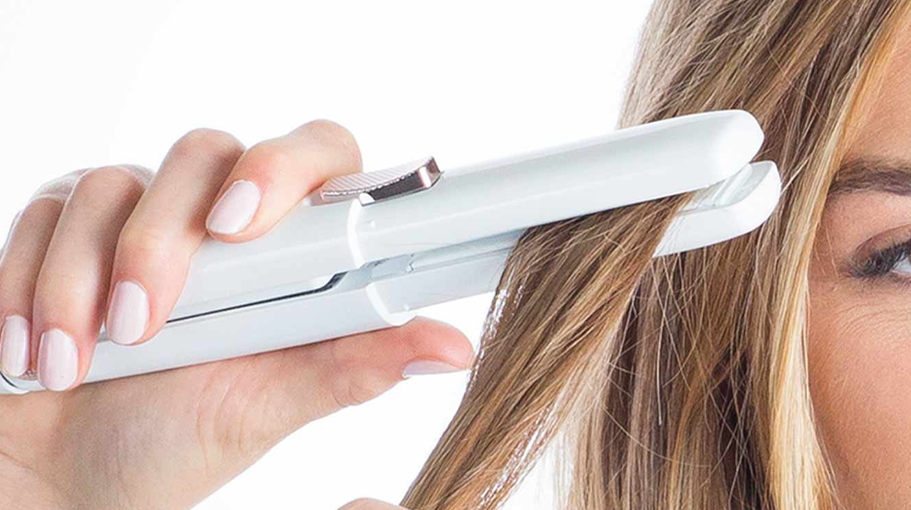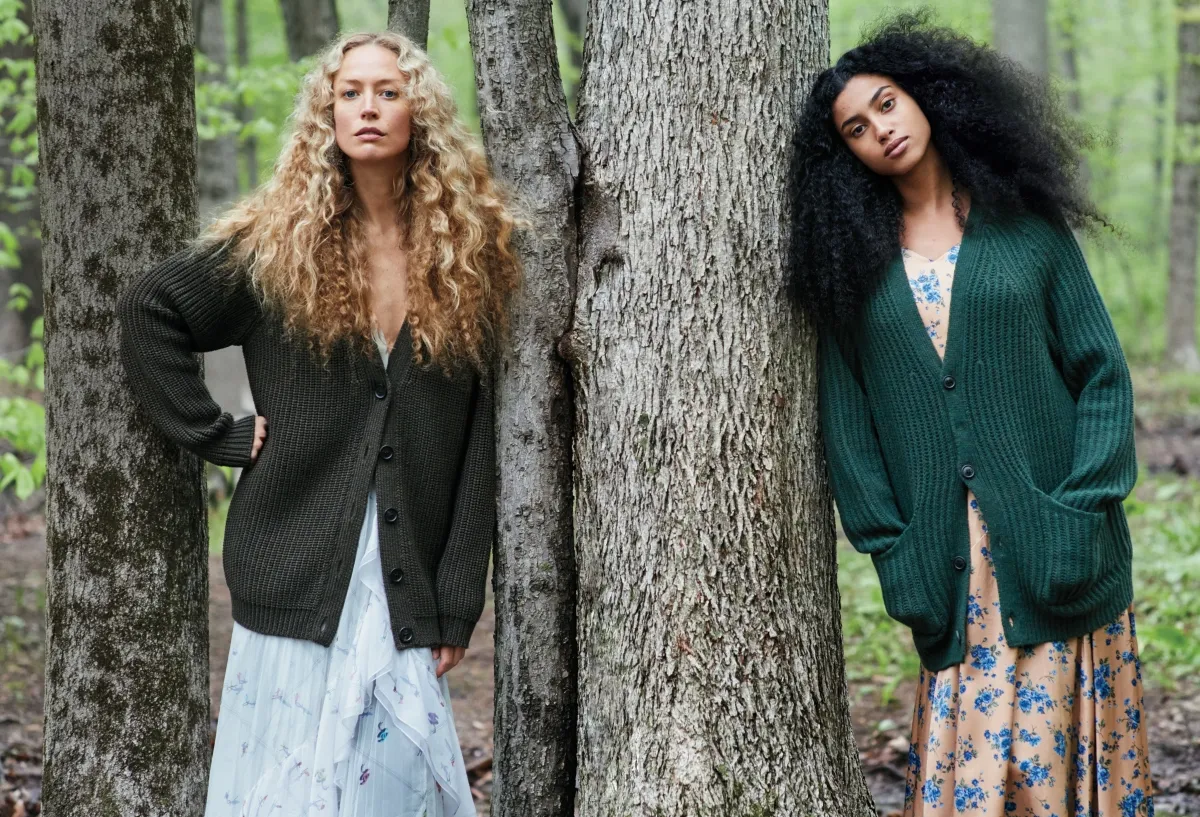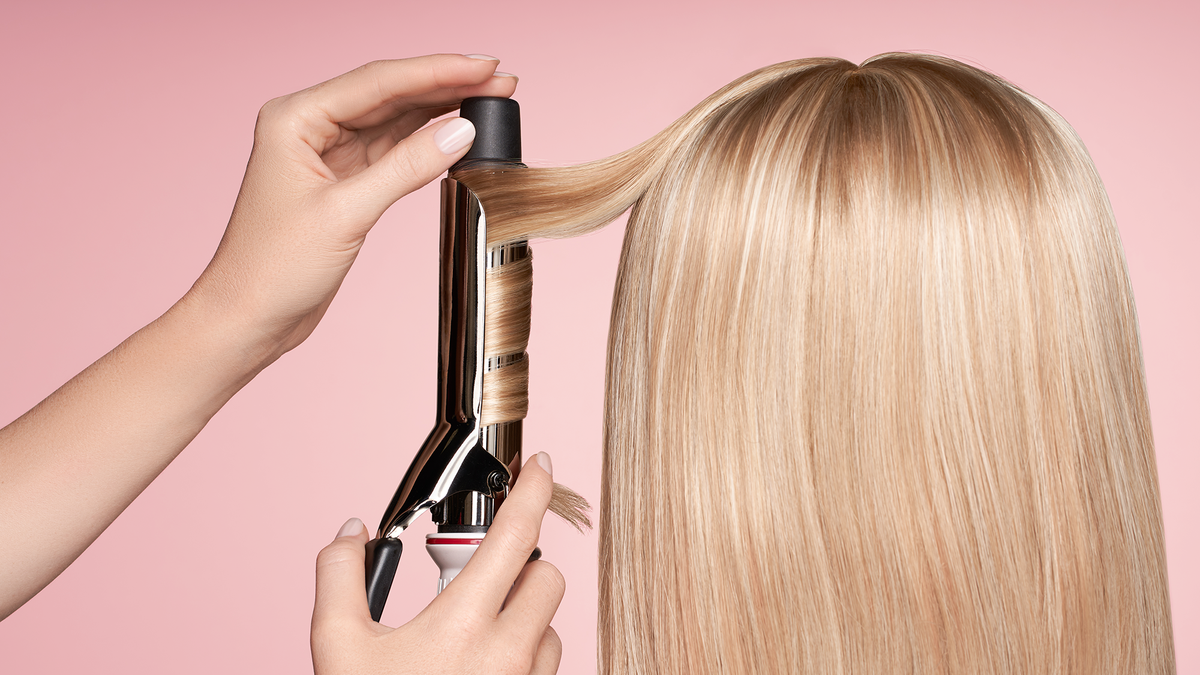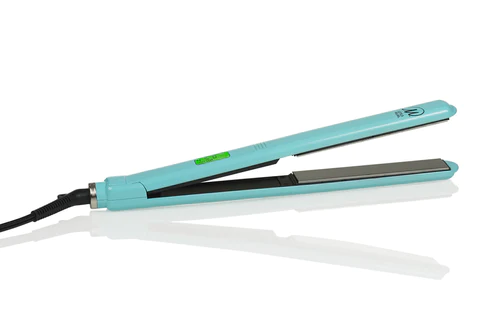Hair
Searching for the Best Hair Straighteners: Buyers Guide

What is a hair straightener?
How does a hair straightener work?
HOW DO I WORK THIS THING?
Simple Steps to Flat Iron Your Hair
Pros and Cons of a Hair Straightener
PROS
- Frizz reduction – Uses heat technology to smooth out frizzy hair and add shine. Looks and feels great. Can eliminate static.
- A quick way to straighten and/or style hair – Most straightening devices heat up very quickly and evenly.
- Hair straighteners are not only for straightening – Many different styles can be achieved in a short time such as crimping and curling. They also work great on bangs.
- Affordable alternative to going to a hair salon – Wide price range.
CONS
- Flat irons are not a permanent solution to straightening curly or wavy hair – Like using a curling iron, the style only lasts temporarily.
- Repeated use can cause hair to become dry and damaged – It’s best used in moderation. However, the better the quality of the hair straightener is, the less damage will be done.
Buying Guide
What is the best flat iron for your hair type?
Plate Size:
Temperature Settings:
Thick hair = higher temperatures.
Thick hair should be able to handle temperatures above 360 degrees Fahrenheit. For thin or normal hair, the ideal temperature setting is up to 360 degrees Fahrenheit. If it is very fragile and thin, it is safest to stay below 250 degrees Fahrenheit. This of course can be adjusted to your preference once you have experience, but it is best to follow the recommended temperatures.
Top 5 Flat Iron Reviews
1. ISA Professional Victorya Flat Iron Hair Straightener Tourmaline Ceramic Plates
- Suitable for both right-handed and left-handed users
- Ergonomic design
- Has a 360-degree swivel cord
- Universal Voltage
- Does not have an automatic shut-off
- If you like to control the temperature of your hair straightener, you may not like the Smart Temperature Technology
My #1 Pick for Best Rated Flat Iron!
- Comes in a designer gift box
- Best professional flat iron warranty out of my top 5
- You can also use it to style your hair with curls, waves, etc.
- Dual Voltage
- Does not have an auto shut-off
- The temperature dial is slightly difficult to read
3. HD Professional 1.25″ Advanced Ionic Tourmaline Hybrid Flattening Iron
- 360° swivel cord
- Auto shut-off feature
- Suitable for all hair types
- Pricier than other flat irons
- The wider plates make it a bit more difficult for short-hair
- Does not have Universal Voltage
4. CHI PRO G2 Digital Titanium Infused Ceramic Flat Iron
Green = 370 degrees for fine hair
Blue = 395 degrees for medium and wavy hair
Red = 425 degrees for coarse hair
- 40 second heat up time
- Comes with a heat-resistant wrap
- Plates have curved edges to glide through the hair with ease
- Dual Voltage
- No auto shut-off
5. HSI Professional Ceramic Tourmaline Ionic Flat Iron
- Easy to use
- High quality
- Dual Voltage
- No auto shut-off
CONCLUSION
Hair
Optimal Hair Care Products for Fostering Hair Growth

The quest for lustrous, voluminous hair is a shared aspiration among many, and selecting the appropriate hair care products can greatly influence the pace and quality of hair growth. While genetics, diet, and external elements shape hair growth, the products we choose play an indispensable role in nurturing the scalp and hair fibers. Here, we delve into the most effective hair care solutions crafted to stimulate hair growth and elevate overall hair vitality.
Understanding the Fundamentals of Hair Growth
Before diving into the specifics of individual products, it’s essential to grasp the core principles of hair growth. Hair emerges from follicles situated on the scalp. Providing these follicles with the requisite nutrients and nurturing support fosters growth while minimizing breakage and hair loss. This underscores the significance of selecting premium hair care items.

Top Shampoos to Stimulate Hair Growth
Biotin-Enriched Shampoos
Biotin, also referred to as Vitamin B7, is a crucial element for maintaining healthy hair. Shampoos fortified with biotin strengthen the hair shaft, mitigate breakage, and promote denser, fuller hair. Seek shampoos where biotin is prominently featured.
Recommended Products:
- OGX Biotin & Collagen Shampoo
- Maple Holistics Biotin Shampoo
Sulfate-Free Shampoos
Sulfates, with their harsh cleansing action, can strip the scalp of essential oils, leading to dryness and irritation. Sulfate-free alternatives gently cleanse while preserving the scalp’s natural moisture, establishing an optimal environment for hair growth.
Recommended Products:
- SheaMoisture Strengthen & Restore Shampoo
- Pura D’or Original Gold Label Anti-Hair Thinning Shampoo

Caffeine-Infused Shampoos
Caffeine invigorates hair follicles and stimulates blood flow to the scalp, encouraging robust hair growth. These shampoos are particularly beneficial for individuals experiencing thinning hair.
Recommended Products:
- Alpecin Caffeine Shampoo
- Plantur 39 Caffeine Shampoo
Conditioners That Foster Hair Growth
Keratin-Infused Conditioners
Keratin, the primary protein that constructs the hair structure, plays a vital role in maintaining hair integrity. Conditioners enriched with keratin repair weakened strands, bolster their strength, and minimize breakage, ensuring that length is preserved.
Recommended Products:
- It’s a 10 Miracle Deep Conditioner Plus Keratin
- Nexxus Keraphix Damage Healing Conditioner
Hydrating Conditioners
Dry and brittle hair is more susceptible to damage. A deeply moisturizing conditioner keeps the hair hydrated, soft, and resilient, thus preventing split ends and encouraging healthy growth.
Recommended Products:
- Moroccanoil Moisture Repair Conditioner
- Aussie 3-Minute Miracle Moist Deep Conditioner
Scalp-Nourishing Conditioners
The health of the scalp is integral to successful hair growth. Conditioners designed to soothe and nourish the scalp can alleviate inflammation and encourage the thriving of healthy follicles.
Recommended Products:
- Nioxin Scalp Therapy Conditioner
- Head & Shoulders Supreme Nourish & Smooth Conditioner
Hair Oils for Promoting Enhanced Growth
Castor Oil
Rich in ricinoleic acid and omega-6 fatty acids, castor oil is a potent natural remedy that enhances hair growth by deeply nourishing the scalp and fortifying hair roots.
Usage:
- Massage castor oil onto the scalp and hair weekly, leaving it to work for at least 30 minutes before rinsing.
Argan Oil
Packed with antioxidants and essential fatty acids, argan oil rejuvenates damaged hair, amplifies elasticity, and promotes an environment conducive to healthy hair growth.
Rosemary Oil
Rosemary oil is renowned for its stimulating effects, which improve blood circulation to the scalp and activate hair follicles, enhancing overall growth.
Usage:
- Combine a few drops of rosemary oil with a carrier oil, such as coconut or jojoba oil, and massage into the scalp.

Leave-In Treatments That Promote Growth
Hair Growth Serums
Serums deliver potent, concentrated ingredients directly to the scalp, addressing hair growth at its core. Look for serums containing ingredients like minoxidil, peptides, or niacinamide.
Recommended Products:
- The Ordinary Multi-Peptide Serum for Hair Density
- Vegamour GRO Hair Serum
Heat Protection Sprays
Excessive heat styling can impede hair growth, leading to weakened strands and breakage. Heat protectants shield hair from the damaging effects of styling tools, helping to preserve hair health.
Recommended Products:
- TRESemmé Thermal Creations Heat Tamer Spray
- CHI 44 Iron Guard Thermal Protection Spray
Supplements for Nourishing Hair Growth
While external treatments are essential, supplements provide critical internal nourishment that supports hair growth, ensuring that the body has the necessary nutrients for optimal hair health.
Biotin Supplements
Biotin, a staple in the pursuit of thicker, stronger hair, is widely recognized for its positive impact on hair health and growth.
Collagen Supplements
Collagen is essential for maintaining the structural integrity and elasticity of hair, making it less prone to brittleness and promoting healthy, vibrant growth.
Iron and Zinc-Enriched Multivitamins
Deficiencies in iron and zinc are common causes of hair thinning. A multivitamin supplement ensures that your body receives these crucial nutrients to support strong, healthy hair.
Recommended Products:
- Nature’s Bounty Hair, Skin, and Nails Gummies
- Nutrafol Hair Growth Supplements

DIY Hair Masks for Growth Support
Egg and Olive Oil Mask
Eggs, rich in protein, paired with the moisturizing and strengthening benefits of olive oil, can work together to foster accelerated hair growth.
Usage:
- Mix one egg with two tablespoons of olive oil, apply the mixture to damp hair, and leave it on for 20 minutes before rinsing.
Avocado and Coconut Milk Mask
The nourishing fatty acids of avocado combined with the hydrating properties of coconut milk create a luxurious mask that revitalizes and supports hair health.
Usage:
- Blend one ripe avocado with half a cup of coconut milk and apply the mixture to the hair and scalp for 30 minutes before washing.

Tips for Maximizing Hair Growth
- Consistency is Crucial: Regularly use your chosen products to achieve the best results.
- Healthy Nutrition: Include protein-packed foods, leafy vegetables, and omega-3 fatty acids in your diet to boost hair health.
- Avoid Overwashing: Excessive washing strips the scalp of its natural oils, which can lead to dryness.
- Limit Heat Styling: Restrict the use of heat tools like curling irons and blow dryers to minimize damage.
- Stay Hydrated: Drink sufficient water to maintain moisture levels in your scalp and hair.
Investing in the right hair care products, coupled with a consistent, health-focused routine, is paramount in achieving the long, thick hair you desire. From shampoos to oils and supplements, these thoughtfully crafted products cater to a diverse range of needs, fostering stronger, healthier hair with every use.
Hair
How to Curl Your Hair with a Flat Iron for Beginners

Curling hair with straighteners step by step: ok, so you’ve decided to purchase a flat iron. You’ve taken it out of it’s pretty packaging, plugged it in and turned it on. Now what? You have different choices in how to use a hair straightener depending on the desired look you are going for.
Are you simply wanting to straighten and smooth, or do you want to add a little twist and shine to your hair without having to use both a curling iron and hair straightener? Below we will walk you through how to curl your hair with a flat iron step by step.
Step 1: Heat Protectant Spray – Optional but Optimal
Although heat protectant spray is optional, it’s purpose is to help protect against heat damage from hot hair tools. If you are going to be using a hair straightener often, this may be a step you do not want to skip. We recommend using a spray such as John Frieda Frizz Ease Heat Defeat or Chi 44 Iron Guard for styling protection from the inside out.
Make sure hair is dry to begin. Divide hair into small sections and spray the protectant over one section at a time. You do not want to make hair wet, but slightly damp. Comb through and wait a few minutes for the hair to dry. Read the specific label on the product for more detailed instructions.
Step 2: Part Hair Into Sections
Once again you will be parting your hair into sections. Tie your hair up into a bun at the top of your head or pin it up to keep it out of the way, leaving the very bottom section down (approximately 1-inch sections). You will be working in layers from the neck up. The smaller the layers, the curlier it will be.
Step 3: Flat Iron Curling Techniques
How to Create Bouncy Curls with a Flat Iron:
Repeat the above curling technique but make bigger layers and larger sections for big bouncy curls. Also start further away from the scalp and glide the iron down the strands quicker than you would for tighter curls.
Beach Waves with Flat Iron:
curling hair with straighteners step by step: Beach waves are a great look, especially if you have long hair to work with. Divide your hair into 4 vertical sections. Take 2 of the sections from 1 side and twist them like a rope separately. Then twist the 2 cords together the same way. Clamp the iron down at the top of the cord (Again, not too close to the scalp!) and work your way down the cord, a few seconds at a time. Allow to cool completely and then unravel the corded hair. Repeat on the other side.
Step 4: Finishing Touches
Once fully curled, simply leave your hair as is or you can run your fingers or a pick through it. If desired you can spray the finished style with a flexible hair spray like Kerastase Laque Dentelle that was seen in the beach waves video. You can also use a wax or pomade like AG Hair Texture Paste to give the hair a smooth, matte look and better keep it in place.
Hair Straightening Tips
- Hair near the hairline is thinner than other areas of the head, so keep in mind that not as much time is needed with the flat iron in that area to get the same result as the thicker areas.
- If may help to spray a section of stubborn hair that does not want to curl with hair spray right before running the flat iron over it.
- Gripping the flat iron on the hair too tightly can cause kinks rather than curls.
- Heat the hair straightener up to the desired temperature ahead of time.
Conclusion
From loose curls to tight curls to flat iron beach waves, there are many different techniques used for curling your hair with a flat iron. Don’t be afraid to play around and discover your own technique or what works best for your hair. Remember it’s best to start with dry hair that has been combed through and optional to spray hair to protect from the heat damage that can occur with repeated use of hot tools. It will get easier the more you practice! I hope you enjoyed this tutorial on how to curl your hair with a flat iron.
Hair
Titanium Flat Iron vs Ceramic

Titanium hair iron vs ceramic: We take hair straightening seriously here at Beautisenz. When it comes to hair straighteners, there are different plate materials available and each has different purposes to suit different needs. Careful consideration should be made when choosing between the different flat iron types; the most important being your hair type. In this article, we will look at titanium vs. ceramic plate material types so that you can better understand the differences and similarities between the two. Scroll down for more information.
What is a Ceramic Flat Iron?
Ceramic straighteners offer excellent value for money. Some of the desired benefits of a ceramic straightener are:
- Smooth glide – they will not tug or pull at hair.
- Quick even heat – they heat up very quickly and evenly so you will not have to make many passes through the hair.
There are also tourmaline-infused ceramic irons on the market. Together they make for a very desirable straightener giving you incredibly shiny locks. Tourmaline is a semi-precious stone that comes in all different colors. The benefits tourmaline brings to a ceramic iron are:
- Generates a larger amount of negative ions that lock moisture into hair, reducing static and frizz.
- Generates infrared heat that penetrates the hair from the inside out making hair smooth and shiny without damage.
- Heats up quickly like ceramic.
Pros & Cons of Ceramic Plates
- Affordable
- Heats up quickly and evenly.
- Glides smoothly over the hair without snagging.
- Great for beginners and those with all hair types.
- Some irons are labeled as ceramic but are merely ceramic coated over aluminum plates and do not retain heat as well. Look for solid ceramic.
- Ceramic is not as durable as titanium. The plates can chip over time due to the brittle nature of ceramics.
What is a Titanium Straightener?
Titanium plates also use infrared heat and negative ion technology to smooth hair and enhance shine.
Pros & Cons of Titanium Plates
- Very durable and scratch-resistant, lasting longer than ceramic plates.
- Reaches high temperatures to straighten stubborn hair.
- Fewer passes need to be made = less exposure to heat.
- Will likely cause damage at it’s high temperatures to thin, fragile hair.
- The more expensive option.
Things to Consider When Making a Choice Between Ceramic vs Titanium Plates
Cost
Ceramic hair straighteners are very common and come in a wide price range. They offer great value for money and are usually cheaper than titanium irons. Keep in mind that the cheaper ceramic irons may not perform as well as the more expensive ones.
Hair Type
Hair type is the most important factor that comes in to play when choosing a straightener. Here are the differences between ceramic and titanium when it comes to hair type:
Ceramic – Good for all hair types from thin to thick hair. Will not work as well on hair that is very thick and stubborn or very curly.
Titanium – Should not be used on thin fragile hair. Great for hair that is thick, coarse and/or curly.
Although ceramic plates heat up pretty quickly, titanium plates will get the job done quicker due to their ability to quickly heat up, retain heat, and allow for fewer passes through the hair.
Experience
If you are a beginner it is best to stick to ceramic hair straighteners until you get the hang of it and discover how your hair reacts to straightening/what temperature your hair straightens best at without causing damage. If you are experienced and know what you’re getting into with straightening hair, the titanium straightener is an excellent choice. Titanium plated hair straighteners are often used by professionals.
The Bottom Line
Ceramic plates provide quick and even heating and are great for all hair types, unless of course, your hair is very stubborn and/or very curly. For a beginner, this is a great place to start. Titanium plates heat up to very high temperatures quickly and evenly. They may cause hair damage that is fine and fragile and are best for professional or experienced users. When it comes down to a titanium hair straightener vs. ceramic, make the choice that is best for your hair type and skill level!
-

 Skin10 months ago
Skin10 months agoNatural Oil-Free Face Moisturizer Reviews & Buyers Guide
-

 Hair10 months ago
Hair10 months agoDoes a Flat Iron Kill Lice? Fact or Myth?
-

 Hair2 months ago
Hair2 months agoDoes a Flat Iron Kill Lice? Fact or Myth?
-

 Skin9 months ago
Skin9 months agoAbout Face Beauty: Tips for Enhancing Your Natural Beauty
-

 Skin10 months ago
Skin10 months agoNeutrogena Naturals Multi-Vitamin Nourishing Face Moisturizer Review
-

 Hair10 months ago
Hair10 months agoFunction of Beauty: Personalized Hair Care for Your Unique Needs
-

 Skin9 months ago
Skin9 months agoBeautiful Nails: Tips and Tricks for Healthy and Gorgeous Nails
-

 Hair20 hours ago
Hair20 hours agoTitanium Flat Iron vs Ceramic

